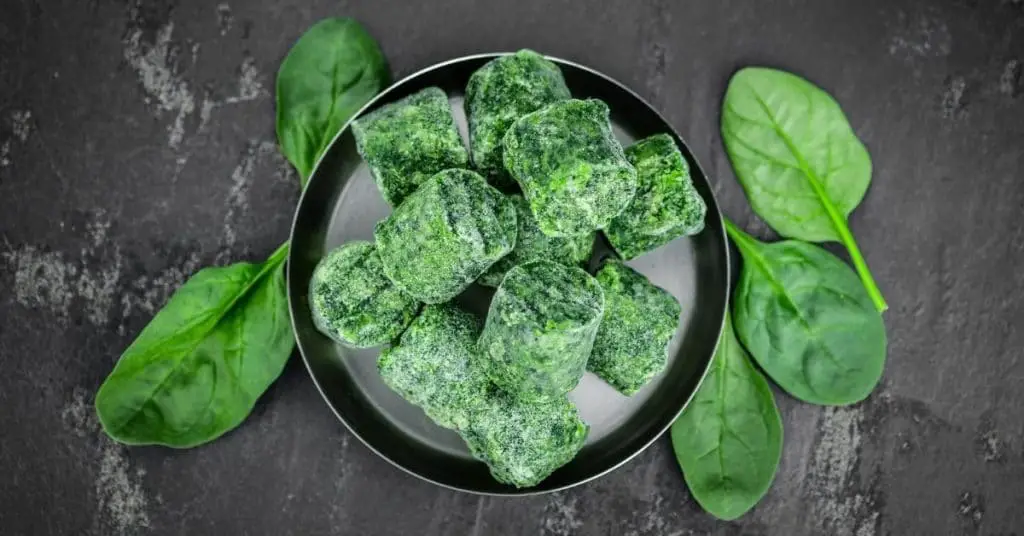In a nutshell: Yes, you can freeze spinach, but it is better to blanch it first to preserve its color, texture, and taste.
Readily available in stores and easy to grow in your own vegetable garden, this leafy green is packed with nutritional goodness.
Used in savory dishes, spinach can be included raw in salads, cooked in stir-fry’s, soups, casseroles, or blended into pesto or smoothies.
Whether your own harvest of fresh spinach has been plentiful, or you have a leftover bunch from the store, the great news is that you don’t have to waste any of it if you cannot use it all straight away.
Spinach wilts quickly and does not stay fresh for long, but luckily it can be preserved in the freezer.
Although the preparation process to preserve spinach for long-term freezing can be somewhat labor-intensive, it will save you time and money in the future, so is well worth the extra effort.
Here is what you need to know to successfully freeze fresh spinach.
Can Spinach Be Frozen?
Yes, freezing spinach is a great way to extend its shelf life. It is advisable to blanch spinach before freezing. Blanching spinach is the process of heat-treating the vegetables in boiling water to stop the naturally occurring ripening enzymatic activity that eventually leads to decay.
Although the enzymatic activity slows down, the enzymes continue to function when frozen. If not blanched, frozen leafy greens will have a less vibrant color, poor texture, and a more bitter taste.
Unblanched spinach that has been frozen will still be edible, but the quality will not be as great. Unblanched spinach is best used in stews, soups, and casseroles where it will be blended in with a variety of other ingredients and flavors.
If you are growing your own spinach, do not let the bunches sit in the garden for too long. Rather harvest and freeze them as the leaves are nutrient-rich and at their best quality when they are newly grown.
How To Freeze Spinach
There are different ways in which you can go about freezing fresh spinach which will largely depend on what you are planning to use it for in the future.
If you are not yet sure, it is advisable to blanch it before freezing as this will allow you to use the spinach as a stand-alone side dish, or to incorporate it with other ingredients. You can use the same methods to freeze fresh baby spinach leaves, swiss chard, and beet greens.
Step 1: Wash
Wash the spinach thoroughly to remove any sand, chemicals, or bugs hiding in the leaves.
To ensure the leaves get a good clean, wash them in salt or vinegar water by filling a large bowl with cold water and adding one to 2 tablespoons of salt or vinegar to the water. Soak the leaves in the water for a few minutes and rinse well.
Step 2: De-stem and Cut
Remove spinach leaves from the stems. Spinach stems can be fibrous and hard to chew, although they do have their place in a stir-fry or pickled.
If you want to freeze the stems, keep them aside to freeze separately from the leaves. Once the leaves have been removed from the stems, cut them into smaller pieces if desired.
Step 3: Blanch
Note: If you are freezing spinach without blanching it, you can skip this step and go straight to step 4. Keep in mind that you will need to use the frozen spinach within one to two months if you do not blanch it.
Heat a large pot of water till boiling. While the water is heating up, fill a separate bowl with ice water. Place your spinach in the pot and let it boil for two minutes. Baby spinach will require shorter boiling time since the leaves are more delicate.
Immediately remove it with a pair of tongs, or strain through a colander and place the leaves straight into the ice water to stop the cooking process.
You do not want your spinach to heat up so much that it wilts; the aim is just to kill the ripening enzymes for preservation purposes and then to stop the cooking process immediately by submerging it into the ice water.
Step 4: Dry
Once cold, remove the blanched spinach from the water and dry it in a salad spinner or pat it dry with a kitchen towel. Any extra moisture on the leaves will form crystals in the freezer which will damage the cell walls, causing the textural breakdown and freezer burn.
Step 5: Pack
There are 3 different ways in which you can choose to pack your spinach for freezing:
Option 1: Freezer Bags
Place the spinach into resealable freezer bags, press out all the air, and seal.
Option 2: Individual Portions
Lightly spray or grease a muffin tray and press down portions of spinach to fill each muffin compartment. Place the muffin tray in the freezer until frozen. Remove the frozen spinach rounds from the tin and place them in an airtight freezer bag.
Press out any excess air at the top of the bag before sealing.
Option 3: Blend
This method is ideal for using spinach in soups, smoothies, or sauces. Place the leaves in a blender and puree the spinach. Add a bit of water if needed until you reach the desired consistency.
Pour the pureed spinach into silicone muffin trays and place the muffin tray in the freezer. Once fully frozen, remove the rounds of spinach puree from the tray and place them into freezer bags. Press out as much air as possible before sealing. Alternatively you can use freezer containers.
Tip: Use ice cube trays to freeze smaller portions. Ice cube spinach is ideal for adding to a spinach smoothie recipe.
Step 6: Label and Freeze
Write the date of freezing on the packaging so you know how long the spinach has been stored in the freezer.
How To Thaw Frozen Spinach
Frozen spinach leaves will defrost quickly at room temperature or by submerging the sealed freezer bag in water.
If you are using the spinach to make a smoothie, soup, or add to a cooked dish such as a casserole or curry, you can add it straight from frozen without thawing.
The spinach will release some moisture as it defrosts during cooking so you may have to adjust the liquid content of your recipe or increase the cooking time.
If you are adding the spinach to a baked dish, quiche, or batter, defrost it first, drain off excess water and then add it to the rest of the ingredients as the additional liquid will change the consistency of the batter.
Types of Spinach
Spinach is a green leafy vegetable and is distinguished by its dark green leaves ranging from 2 cm to 30 cm tall. The vegetable is grown for its large nutrient-rich leaves, however, the stems can also be eaten if prepared accordingly.
Spinach comes in many varieties, each with its own distinct leafy features. The 3 main types however are savoy, semi-savoy, and flat- or smooth-leaf spinach.
Savoy spinach has large, thick wrinkled leaves, whereas, semi-savoy spinach leaves are not as wrinkled, and some partially straight. This type of spinach is most often grown in home gardens. As its name suggests, flat-leaf spinach has smooth and flat leaves and is the easiest to clean.
Fresh spinach leaves are sold loose, in a bunch, or packaged in sealed refrigerator bags. Although nutritional value does decline over time and with processing, spinach is also sold canned, cooked, and frozen for longer shelf life.
FAQs
Conclusion
Keeping spinach prepared and frozen will save you prep time, food waste, and money. Frozen spinach will not have the same crunch as its fresh counterpart so will not be great for salads, but it is fantastic in cooked dishes such as creamed spinach, soup, stir-fry, quiche, in pasta, and baked into muffins.
If blanched before freezing, spinach can be kept for up to a year in the freezer. That means you can simply grab a bag of greens from the freezer and add it to your desired recipe. Getting your fill of vegetables couldn’t be easier.
Learn more how to freeze lettuce, kale, carrot, broccoli, cauliflower, green onions, celery, asparagus, cabbage and brussel sprouts.
*image by HandmadePicture/depositphotos









